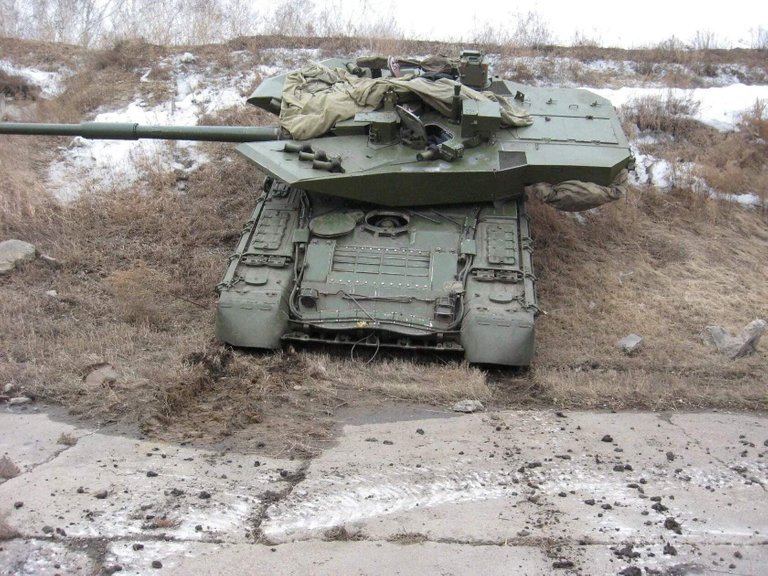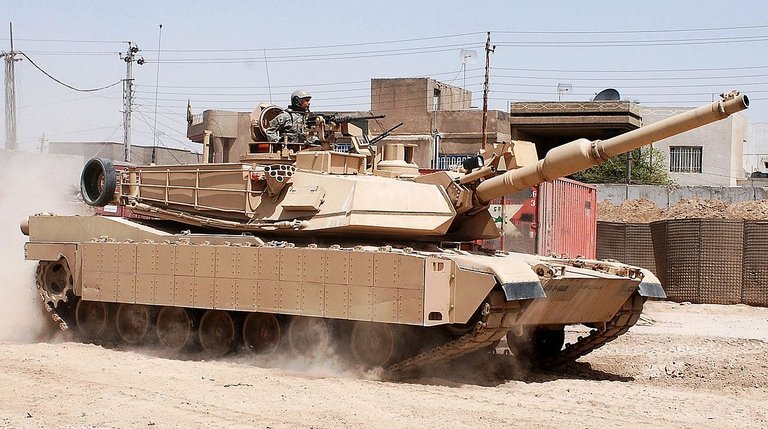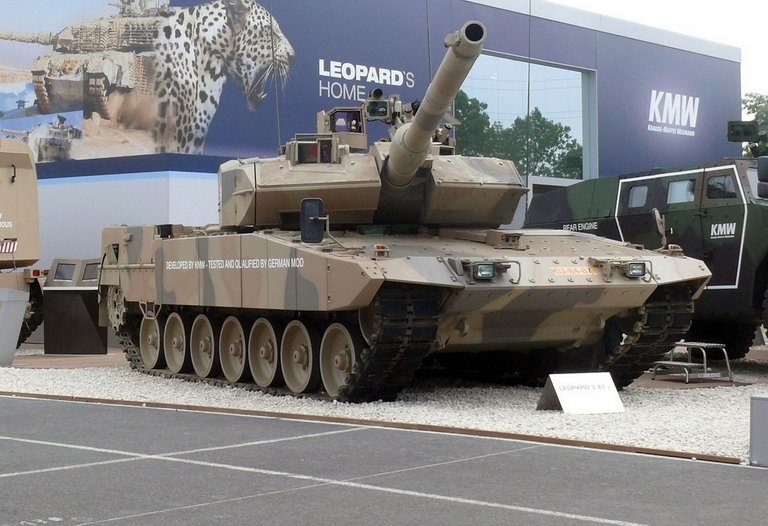Future tanks in the making: 10 exciting developments that could dominate the battlefields in the upcoming years
Hello LeoFinance!
I put a few days of research on the internet before I decided to write and post this on the Hive blockchain. I hope that you like tanks, because this is a "tank post".
Whether or not there is still a need for general battle tanks in modern forces is a regular topic of debate among those interested in military technology, but looking at current global force development projects, the picture that emerges is that tanks will clearly remain on the battlefield in the coming decades. Whether it is upgrading existing types of combat vehicles or designing new types of tanks, many countries have set out in recent years to develop their armoured capabilities, including the United States, the major European powers, India and Russia. I look at ten exciting tank development projects from around the world.
1 - "Burlak"

Image source: https://scontent.fbud7-1.fna.fbcdn.net.
The Russian army has the largest number of tanks in the world, but many of the combat vehicles are still from the Soviet era and need constant modernisation to keep up with technological advances.
Recently, some photos have been leaked on the internet showing what appears to be Russia's relaunch of an older tank development programme aimed at upgrading its Soviet-era T-72, T-80 and T-90 tanks. The programme is probably called Burlak, and its main aim is to increase the firepower and immunity of the old tanks, but little else is known about it for the time being due to the lack of publicity.
2 - T-14 Armata

Image source: https://upload.wikimedia.org.
It's not just old tanks that are being modernised in Russia: in 2015, the T-14 Armata, a tank that caused a sensation, was unveiled at the Victory Day parade and was met with great admiration by the entire Western public. The tank is supposed to have a number of innovations; it requires only two operators, the turret is controlled from the body by the gunner, it is protected by a number of modern defence systems and it has a new type of 125 mm gun, which the Russians claim exceeds the capabilities of Rheinmetall's 120 mm gun.
To date, the Armata has not been widely adopted, mainly because it has proved too expensive to mass-produce, but the programme has not been completely halted by the decision-makers. Experiments are currently under way to make the combat vehicle self-driving and remote-controlled.
3 - The "North Korean Armata"
Despite the disruption, the Armata has inspired military leaders in many countries to develop their own armoured vehicles, most clearly in North Korea, where they have copied the Russian military vehicle almost one-for-one.
Last year, at a ceremony to mark the 75th anniversary of the founding of the Korean Workers' Party, 9 new tanks were paraded, showing many similarities with the Armata (and to a lesser extent with the US Abrams), but with capabilities that hardly approach either their Western or Russian rivals. Some speculate that the new combat vehicle is little more than an old T-62 in terms of combat value, with the most that has been improved is that the new design provides better armour protection and it is possible that it has been fitted with an infrared camera and a self-loading device, although there is no evidence of this.
Western experts refer to the "Korean Armatas" as the "M2020," but it is unclear whether this is the name used by the DPRK leadership.
4 - Future MBT (FMBT) (Arjun)
India announced back in the early 2010s that it was developing a completely new tank to replace the Arjun tanks currently in service. The concept was for a specially designed lightweight, small tank requiring only two operators and providing greater armour protection than the modernised Arjun Mk. 1A combat vehicles.
The FMBT project has so far proved to be a huge money sink and despite the defence ministry expecting a 2025 entry into service, not even a prototype will be produced until 2021. It looks very much as if the Indian leadership will prefer to modernise the Arjuns slowly instead of developing a completely new type, or buy combat vehicles from abroad when this type is obsolete. However, no official decision has yet been taken to stop the FMBT project.
5 - Altay
The Turks have been working on developing their own tank since the mid-2000s, and the programme looks set to be a success after more than $1 billion of investment and the involvement of a number of Turkish companies.
The combat vehicle, named Altay, is a derivative of the South Korean K2 Black Panther tank, with the first fully operational prototype completed in 2016, but mass production has not yet started due to the German embargo on the Turkish military industry. Despite the disruptions, the systemisation is expected to start this year.
6 - Challenger 3
At the beginning of May, the British announced that 148 Challenger 2 tanks would be modernised at a cost of around £800 million, with the new vehicles to be Challenger 3. The primary aim will be to digitise the combat vehicles, but the Challenger will also receive a new turret, engine and gun, which will increase both their firepower and survivability.
The first Challenger 3s are expected to enter service in 2027.
7 - European MBT
The development of the European Main Battle Tank (EMBT) was launched in 2012, when Germany and France decided it was time to replace their Leopard 2 and Leclerc combat vehicles with a newer type.In 2018, a demonstrator was presented, with which the French Nexter and the German Krauss-Maffei Wegmann wanted to prove that they could work together; this combat vehicle was essentially a Leclerc turret on a Leopard 2, without any major technological breakthroughs.
The collaboration has since expanded and evolved, with the current development, codenamed Main Ground Combat System, aiming to create an entirely new combat vehicle, which would be fitted with a 130 millimetre gun and would be able to control drones for the operator, as well as equipping the vehicle with autonomous capabilities. According to the companies involved, the development could be completed by 2035.
8 - M1A2D Abrams

Image source: https://upload.wikimedia.org.
The M1 Abrams tank was introduced into service in the US Army in the 1980s and was long considered by military experts to be the best tank in the world, mainly because of its outstanding performance during the Gulf War. But nowadays, however you look at it, this combat vehicle platform is 40 years old and there are many other tanks that, at least in principle, are more capable than the Abrams.
Regardless of this, the decision-makers responsible for the development of the US force are still working on upgrading the Abrams rather than developing and systematising a completely new type of vehicle. Currently, they are rebuilding the existing armoury to M1A2D/SEPv4 standards; the Abrams will also receive new targeting aids, meteorological sensors, smoke grenades and a new type of ammunition. The modernised combat vehicles will enter service in 2021.
9 - Leopard 2A7+

Image source: https://upload.wikimedia.org.
In 2018, the Minister of Defence of Hungary, Tibor Benkő announced that Hungary would buy 44 Leopard 2A7+ battle tanks from Germany. The delivery of the equipment is expected to start in 2023 and the tanks will be registered as Leopard 2A7+HU.
The Leopard 2A7+ tanks are currently among the absolute world leaders in terms of the available supply of operational, mass-produced tanks, but given the thinking of Hungarian force development decision-makers, it is almost certain that new technologies will be added to the combat vehicles as Hungary's military industrial capabilities develop. As is well known, a factory is being built in Zalaegerszeg, where Lynx infantry fighting vehicles and related equipment will be produced initially, but in the longer term other capabilities are expected to be developed at the plant, and it is already apparent that Rheinmetall would bring a number of defence R&D activities to Hungary in the future.
The results of Hungarian military R&D projects in the coming years and decades will almost certainly be seen on Leopard tanks modified to meet Hungarian needs, and it is not even out of the question that Hungary will start developing new tanks or join the European MBT programme in the 2020s.
10 - A new type of 8x8
As is known, Hungary will also develop a new type of 8x8 combat vehicle and is in the process of joining the pan-European helicopter family development. It is therefore realistic that such a step will also be taken in the field of armoured vehicles.